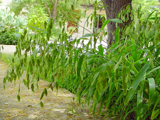Native Plants

Q. Who is Mr. Smarty Plants?
A: There are those who suspect Wildflower Center volunteers are the culpable and capable culprits. Yet, others think staff members play some, albeit small, role. You can torture us with your plant questions, but we will never reveal the Green Guru's secret identity.
Did you know you can access the Native Plant Information Network with your web-enabled smartphone?
Ask Mr. Smarty Plants is a free service provided by the staff and volunteers at the Lady Bird Johnson Wildflower Center.

rate this answer
Thursday - July 28, 2011
From: lackawaxen, PA
Region: Northeast
Topic: Water Gardens, Erosion Control, Shade Tolerant, Grasses or Grass-like
Title: Erosion prevention on shady Pennsylvania stream
Answered by: Guy Thompson
QUESTION:
I'm looking for a few species to plant along a stream channel to help reduce erosion during heavy rains. The soil is moist and in full shade. Ferns and thorny bushes are the only current vegetation under the oaks and beach trees. There are plenty of deer and other critters about that might complicate the choice.ANSWER:
Mr. Smarty Plants suggests that if you have a persistently wet area, consider Juncus effusus (Common rush), a species that will grow in water-saturated soil. I would plant the lower stream bank with sedges, which, unlike most grasses, will thrive in shade. Carex pensylvanica (Pennsylvania sedge) or Carex blanda (Eastern woodland sedge) should form a dense turf that resists soil erosion. Patches of Aquilegia canadensis (Eastern red columbine) at this level would provide color. A bit farther up the bank, I recommend Chasmanthium latifolium (Inland sea oats) and Parthenocissus quinquefolia (Virginia creeper). Either of these will produce a dense ground cover, with Virginia creeper remaining at ground level if there are no nearby trees or shrubs to climb. Flowering plants to consider include Campanula rotundifolia (Bluebell bellflower), Lobelia cardinalis (Cardinal flower), and Claytonia caroliniana (Carolina springbeauty). An understory small tree, Cercis canadensis (Eastern redbud) might complement the other species. If the upper bank is usually quite dry, Arctostaphylos uva-ursi (Kinnikinnick) will create a solid ground cover.
Check out this list of local suppliers for the species recommended above. Once established, these plantings should solve the problem of erosion threatened by both large and small storms. The ground covers and sedges are resistant to deer herbivory.
From the Image Gallery
More Water Gardens Questions
Winter tank pond care in Austin Texas
November 09, 2010 - Suggestions for winterizing a water garden in Austin Texas. Water contained in a 60 gallon aluminum horse tank. Garden contains papyrus, horsetail and water lily. There are no fish in the pond and no...
view the full question and answer
Plants for retention ponds in Grand Haven, MI
July 21, 2009 - I am president of a condo association. We have three retention ponds on the property. From two of them we pump water for irrigation so the water level goes up and down. We are going to try to stabiliz...
view the full question and answer
Tradescantia as a water plant
June 13, 2007 - I have a spiderwort plant, and when I found it at the nursery, it was in water by the pond plants, (I had no idea what kind of plant it was at the time) So I bought it, took it home, and repotted it w...
view the full question and answer
Problems with non-native bi-color iris from Spring Branch TX
August 18, 2011 - Bi colored iris. I have four plants planted around our water feature last fall. Up until recently they all looked very healthy, yet not blooming. Several weeks ago I noticed that two of the plants ...
view the full question and answer
Specifying sizes of plants for pond edge plantings in Austin area
December 19, 2014 - I am working on a list of pond edge plantings for the Austin area that will be in the fluctuation zone and I have my list of my plants but I need to know how to spec the sizes and to make sure my list...
view the full question and answer
| Support the Wildflower Center by Donating Online or Becoming a Member today. |

